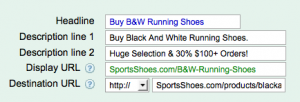 Google is judging your keywords for quality, judging them hard.
Google is judging your keywords for quality, judging them hard.
There are a lot of ways to improve low quality score keywords, and with Google’s new improvements to quality score, they’re making it a little more transparent as to what you need to do to improve your low quality score keywords. I’ve found in my accounts that it’s most often ad relevancy and/or expected click-through rate. Since these are the easy, faster fixes–they’re the ones I focused on first. Landing page fixes can take up to six weeks for Google to recognize. You should still do those, and we have a hilarious little video blog on how to do that, but I wanted to share with you today something I did in one of my accounts to increase quality score through ad relevancy and CTR.
1.) Identify your most likely to succeed low quality score keywords.
I just downloaded a keyword report and filtered out any quality scores higher than 2/10. From there, I looked through to see if any had converted. Those are good places to start. Otherwise, though, just look through your keywords at ones you think should work. So, let’s say you sell shoes, and one of your low quality score keywords is “black and white running shoes”, and you not only sell those, but have a landing page for them. That’d be a great keyword to pick to target. I also want to suggest that you only use exact or maybe phrase match at first. Especially if you’re picking general short-tail keywords. If you take something like “shoes” that was limited by a low quality score at broad match and take it even to a 3/10, you’re really opening up the flood gates, and you could spend a lot really quickly. You may or may not see the return on that keyword. So, for me, I only used exact match for this.
2.) Make a whole new campaign for your low QS keywords.
This is not only going to make it easier to manage your breakouts, but it’s going to also ensure any campaign level quality scores won’t affect your new campaign. Just the account wide quality score. I called my campaign “Low Quality Score Breakouts”.
3.) Breakout your ad groups in the most segmented way possible.
The point of this whole thing to make the most targeted ads possible, so even if it means having an ad group for each word, doooo eet! So, put “black and white running shoes” in a separate campaign from “red running shoes”. Just think: if I’m writing an ad for this ad group, can I write one with a keyword in it and it’ll make sense to people searching for the other keywords? You could have “black and white running shoes” “white and black running shoes” “running shoes in black and white”, etc. all in the same ad group, for example.
4.) Write two ads to test against each other for each ad group. The most targeted, relevant ads you’ve ever written in your little ‘ol PPC life. Here’s a good one for the example we’ve been using:
If you need more help writing ads, check out this webinar the lovely miss Kayla Kurtz did a couple of months ago on ad writing and testing.
5.) Set up test budgets and push those suckers live!!
I have a budget I have to stay in every month, so I did some mathing (that’s a verb, now) to figure out how much I want to spend on these keywords and this campaign. You want something that’s going to allow your keywords to get enough clicks to convert, but something that’s not putting your account at risk of tanking metrics for the month. If you need some help with this, check out our blog article about bookending for new keywords.
6.) Check your results.
Drumroll, guys…the SAME DAY I did this, one of my 2/10 keywords went to a 4/10 and converted twice at 20% of our goal cost per conversion.
Keyword before breakout:
Keyword AFTER breakout:
So, that’s what I’ve got for you, folks. And I think it’s pretty spectacular. Let me know if you have any similar stories, suggestions for things I should do differently, or fun comments!







